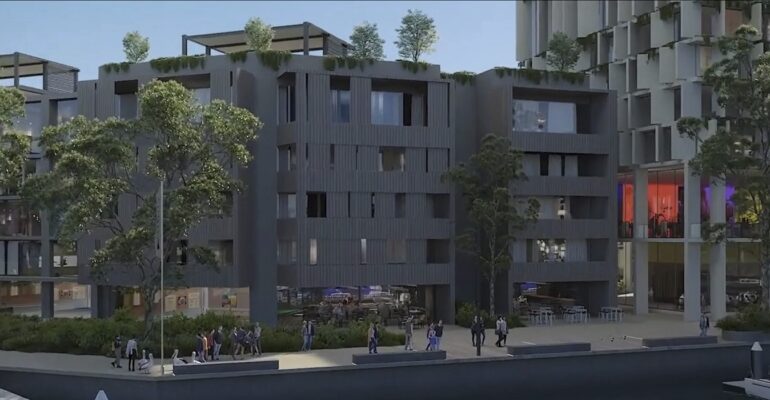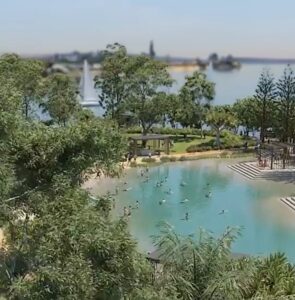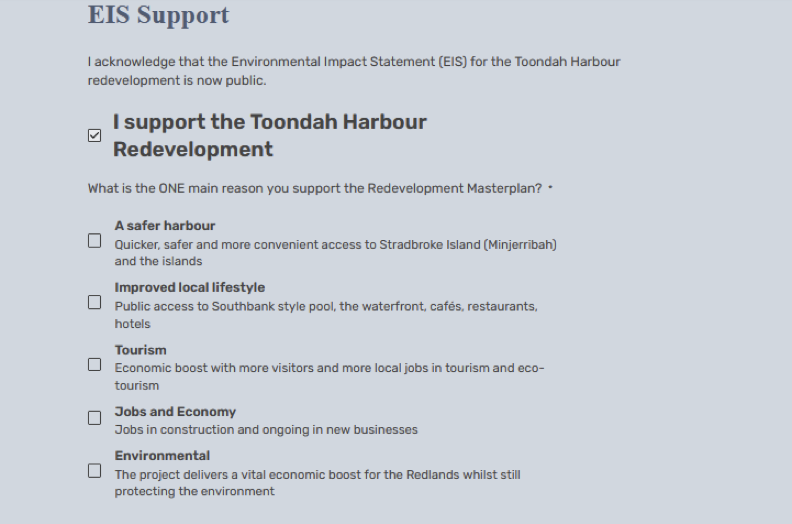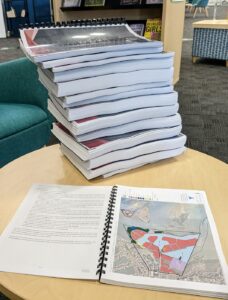
Some of the buildings proposed for Toondah Harbour – from one of Walker Group’s Draft EIS videos
Walker Group has issued its draft Environmental Impact Statement (EIS) for its proposed Toondah Harbour Development. The Toondah EIS has been four years in the making as it was a requirement set by the then Minister for the Environment and Energy in July 2018.
It is salutary to note that the developer has had four years to marshal a large team of consultants coordinated by a leading firm of planners whose claims include that they have the “know-how to deliver……new commercially responsive land developments“.1
Reviewing the Toondah EIS
The ‘public’ has forty days to make comments back to Walkers who must ‘take account’ of comments received and prepare a final report to the Minister.2
In turn, Tanya Plibersek, the Federal Minister for the Environment and Water is expected to make a decision within 40 days of receiving the final EIS from Walkers.
Decisions such as the one about the proposed Toondah Harbour development are contentious. They are political. The aim of an EIS is to reduce, not remove, contention. It does so by sharing base data and making evaluations of alternatives.
The alternatives include not undertaking the development and doing the overall project and its components in a range of different ways. Such analysis, done well, will crystalise the issues and make decision-making sharper. Unfortunately, I do not think the Toondah Harbour EIS has done this.
One issue is that very limited alternatives to the developer’s scheme are considered. In particular, the possibility of building the proposed 3,600 dwellings somewhere else in Redland City is not considered. Nor are the options of a smaller development examined.
A second major issue is that the developer seems to be telling two different stories; one is that the project is about constructing very substantial and significant housing and commercial space. The other is that the project is designed about altering the Fison Channel which is the entrance to Toondah Harbour and the housing is almost incidental.
The result is that it is never exactly clear just what is being evaluated in and by the EIS.
This seems very strong grounds for rejecting this EIS. Instead, Redland City Council and the Queensland Government must reconsider the rationale of the scheme they formulated for the Toondah Harbour Priority Development Area in 2013.
The purpose and conduct of environmental impact assessments
One objective of the Environment Protection and Biodiversity Conservation Act (EPBC) is to “ensure activities that are likely to have significant impacts on the environment are properly assessed”.3
The Federal Environment Minister can require the preparation of an Environmental Impact Statement as part of the assessment process. If an EIS is required it should meet the standards of the EPBC, the EPBC Act Significant Impact Guidelines4 and specific terms of reference for the project – in this case the Guidelines for the Preparation of A Draft Environment Impact Statement for the Toondah Harbour Development.5
These are very explicit; for example
- the express intention is “proper assessment”6
- “information provided in the EIS should be objective, clear, succinct”7
- “any and all unknown variables or assumptions made in the assessment must be clearly stated and discussed“8
- The assessment must cover “all adverse impacts which result from the action, including indirect and offsite impacts”9
- “beneficial impacts cannot be offset against adverse impacts”.10
The overall test is that environmental assessment should be done in a responsive and responsible fashion.11 As summarized by the American Bar Association:
An EIS outlines the status of the environment in the affected area, provides a baseline for understanding the potential consequences of the proposed project, identifies positive and negative effects for the environment, and offers alternative actions, including inaction, in relation to the proposed project.12
At its best, the EIS process can be dispassionate with data and information presented carefully together with transparent analysis and interpretation that sets out all assumptions and shows where there are gaps and contentions.
Environmental assessment is not a marketing tool

The Toondah EIS seems to be part of the promotion and marketing of the development. This is very clear in the video which is the first thing offered to those who go to the EIS Virtual Information Centre set up by the developer. One ‘goes through’ the video to get to the EIS report and documents.13
The same website includes an invitation to “offer support for the project” and choose the one main reason for offering support. Moreover, the ‘tick and click’ serves as a submission to the draft EIS – whether or not any of it has been read.
There is no facility to indicate one does not support the project. In a similar vein, the developer has been advertising in the Redland Bulletin complete with a QR code that registers automatic support14 for the project.

Two stories in the Toondah EIS
The developer appears to be telling two different stories. The Executive Summary of the EIS starts with the dredging of the Fison Channel with the dredged material beneficially reused to reclaim a 37.6 a sub-tidal area north of the harbour to create new landforms for proposed public open space and urban uses.15 This downplays the size and scale of the property development and almost hides it behind the dredging. The 3,600 dwellings are almost an accidental outcome of the dredging of the channel needed to allow bigger boats and hence more tourists to Minjerribah.
In contrast, the developer’s ‘publicity material about Toondah emphasises the extent of the housing and commercial building. For example:
Spread over 67 hectares (17.5 on land and 49.5 over water), this $1.3 billion precinct will deliver residential dwellings, commercial space, retail and eateries within a contemporary urban village, new public open space and up to 400 berth marina.16
Property development is, however, at the heart of the economic value of the project. Thus:
The vast majority of the economic benefits derived from the Project are accounted for by the economic value of the land created by the development to be used for residential, commercial and retail purposes. Likewise, the capital costs account for the majority of the economic cost under the Project case.17
The Draft EIS, estimates the net present value of retail, commercial, and residential development as $1.24 billion and the value of increased tourism expenditure on Minjerribah as $9.1 million! The property development is 97.6 per cent of what is termed the value of the Economic Benefits of the project.18
Some clarification is needed about how to understand the project. Is it best represented?
- As a large property development of 3,600 dwellings and commercial spaces which will have an incidental benefit of some dredging and increased tourism or
- As a scheme to improve ship navigation and tourism that incidentally will provide some housing for Redlands.
The economics say it is a property development, but the Toondah EIS concentrates on tourism and shipping. As shown, almost all the other publicity from the developer focuses on the scale and size of the development.
One can only speculate on why the EIS downplays the housing as the justification for the project. One possible reason is that the 3,600 dwellings are factored into the long-term planning for Redland City in the South-East Queensland Plan. If so, one alternative that should have been examined is where else the dwellings could be built in Redland City instead of on a Ramsar site. This is ruled out in the EIS on the grounds that the Proponent’s proposal is tied to specific land in the Toondah Harbour PDA under binding commercial agreements with the Queensland Government and RCC. 19
This is a convenient argument for the developer but hard to fit into the logic of environmental impact assessment.
Reject the Toondah EIS, review the PDA
Overall, it is very difficult to accept that the Toondah EIS is a ‘proper assessment’ under the EPBC Act since the ability to consider alternatives is very restricted. These seem very strong grounds for rejecting the Toondah EIS.
Instead, Redland City Council and the Queensland Government must reconsider the rationale of the scheme they formulated for the Toondah Harbour Priority Development Area in 2013.
Howard Guille
Minjerribah
Footnotes
- Saunders Havill Group, About Us, https://www.saundershavill.com/about-us/
- According to the Environment Protection and Biodiversity Conservation Act 1999 (EPBC), the finalised statement must:
- take account of any comments received within the period for comment; and
- contain a summary of any such comments and how those comments have been addressed. (s104 (3))
- Environment Protection and Biodiversity Conservation Act 1999, s3(d) https://www.legislation.gov.au/Details/C2014C00506/Download
- Matters of National Environmental Significance, Significant impact guidelines 1.1, Environment Protection and Biodiversity Conservation Act 1999 https://www.dcceew.gov.au/sites/default/files/documents/nes-guidelines_1.pdf
- EPBC 2018/8225 http://epbcnotices.environment.gov.au/_entity/annotation/f4225aa8-9b56-e911-b854-005056842ad1/a71d58ad-4cba-48b6-8dab-f3091fc31cd5?t=1554647617164 Note this is Appendix 1-B of the Draft EIS
- EPBC Act s3 (d) ensure activities that are likely to have significant impacts on the environment are properly assessed;
- Toondah EIS Guidelines p4
- Toondah EIS Guidelines p4
- Significant Impact Guidelines p6
- Significant Impact Guidelines p6
- US Bureau of Ocean Energy Management, What Is The Environmental Impact Statement (EIS) Process? https://www.boem.gov/environment/environmental-assessment/what-environmental-impact-statement-eis-process
- Tiffany Middleton, What is an Environmental Impact Statement?, American Bar Association, 2021, https://www.americanbar.org/groups/public_education/publications/teaching-legal-docs/teaching-legal-docs–what-is-an-environmental-impact-statement-/
- https://caportal.com.au/walker/toondah-vic?hview=modalWelcome
- https://www.toondah.com,au/eis-support/
- https://caportal.com.au/walker/toondah-vic?hview=modalWelcome
- https://www.walkercorp.com.au/residential/toondah-harbour/
- Executive Summary p38
- Table 21-1: Summary of Economic Benefits under the Project Case, Draft EIS, Chapter 21, Economic Assessment
- Ch 1 Project Details p22. The PDA agreement was made in 2014 under the then LNP Government.
Redlands2030 – 20 November 2022
Please note: Offensive or off-topic comments will be deleted. If offended by any published comment please email thereporter@redlands2030.net

4 Comments
I don’t believe the environment will be safe if this disaster at Toondah Harbour goes ahead, I recently went for a walk along the path beside the creek bordering Capalaba Central Shopping Centre and up stream towards Alexandra Hills, the amount of rubbish that is on the creek bank is astonishing, plastic wrap off of wine bottles, food packaging, 3 Shopping trolleys that is a for runner for what is possible when you build at the waters edge.
Stop destroying the environment and put this disaster to bed.
The question remains as to how this real estate proposal to construct 3600 units comprising in the order of 40 X 10 story apartments in Moreton Bay Marine Park and internationally protected Ramsar protected wetlands ever got so far. The answer is clear. The former Environmental Minister made a POLITICAL decision in contradiction to the advice of his own department summarised as being that the proposal was unacceptable from an environmental aspect with no prospect of remedial action. The draft EIS fails to address or offer acceptable offsets or develop a case to encroach on Ramsar protected wetlands.
The draft EIS acknowledges the profit driven real estate nature of the development by claiming a NPV of $1.24 B for the reclaimed land with tourism benefits of $9.1M .
Clearly the environmental destruction, social and loss of public amenity strongly indicates that the draft EIS has not addressed the criteria of EPBC and be declared as unacceptable .
Thank you for a very lucid examination of a very flawed EIS.
One very clearly and rationally presented case why the housing development part of this project should not proceed. There are many others, such as the project being inconsistent with the provisions of the Ramsar convention to which Australia is a signatory, the EIS failing to demonstrate a “net benefit”, and shortcomings in a number of the technical parts of the EIS. As the local slogan goes: “Stop the rort! Just fix the port!